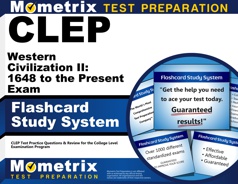The College Board administers the College-Level Examination Program (CLEP), which offers affordable exams that help students receive college credits. This article covers the CLEP Western Civilization II exam, which covers the period from 1648 to the present day.
Click “Start Test” above to take a free CLEP Western Civilization II practice test, and check out our premium-quality CLEP test prep resources by clicking the links below!
What is the CLEP Western Civilization II Test?
As mentioned previously, CLEP tests can be taken to earn college credits for the things you already know. If you have learned the test material through on-the-job training, previous studies, or simple life experience, you can take this one exam and receive college credit as if you took the one-semester course!
By taking and passing the CLEP Western Civilization II test, you can skip the second semester of the Western civilizations course at college. This will potentially:
- Allow you to earn three or more college credits
- Save you money because the test is cheaper than a semester at college
- Allow you to graduate on time or possibly to graduate ahead of schedule
- Add flexibility to your degree program
Taking the CLEP Western Civilization II test can save you from hours of classwork and all of the hours of homework that professors assign. You should check with your college before taking this test to make sure they will accept it.
Eligibility
CLEP tests are open to anyone to take at any time! There are no age restrictions or educational requirements.
Here are some examples of who takes the CLEP Western Civilization II test:
- College students
- High school students who are preparing to graduate
- Homeschool students
- Adults who are returning to school
- Professionals who want to use the exam results to help advance their careers
- Applicants to master’s degree programs that still have undergraduate prerequisites they need to fulfill
Test Outline Review
The CLEP Western Civilization II test contains 120 questions and has a time limit of 90 minutes.
Every question on the test is designed to test one or more of the following abilities:
- Your ability to understand important factual knowledge of developments in Western civilization
- Your ability to identify the causes and effects of major historical events
- Your ability to analyze, interpret, and evaluate textual and graphic historical materials
- Your ability to distinguish the relevant from the irrelevant
- Your ability to reach conclusions on the basis of facts
The questions are split into 12 content categories.
Absolutism and Constitutionalism from 1648–1715 (7%–9%)
The questions in this section cover the following topics:
- The Dutch Republic
- The Westernization of Russia
- France under Louis XIV
- Formation of Austria and Prussia
- The English Revolution
Competition for Empire and Economic Expansion (4%–6%)
The questions in this section cover the following topics:
- Global economy of the 18th century
- Demographic change in the 18th century
- Europe after Utrecht from 1713–1740
The Scientific View of the World (5%–7%)
The questions in this section cover the following topics:
- Political theory
- New knowledge of man and society
- Major figures of the scientific revolution
Period of Enlightenment (7%–9%)
The questions in this section cover the following topics:
- Enlightened despotism
- Enlightenment thought
- Partition of Poland
Revolution and Napoleonic Europe (10%–13%)
The questions in this section cover the following topics:
- The French Revolution
- The European Revolution
- The French Empire
- Congress of Vienna
The Industrial Revolution (7%–9%)
The questions in this section cover the following topics:
- British reform movement
- Agricultural and industrial revolution
- Economic and social impact on working and middle class
- Causes of revolution
Political and Cultural Developments from 1815–1848 (6%–8%)
The questions in this section cover the following topics:
- The Revolutions of 1830 and 1848
- Liberalism
- Socialism
- Conservatism
- Nationalism
Politics and Diplomacy in the Age of Nationalism from 1850–1914 (8%–10%)
The questions in this section cover the following topics:
- Socialism and labor unions
- European diplomacy from 1871–1900
- The unification of Italy and Germany
- Russia
- Austria-Hungary
- France
Economy, Culture, and Imperialism from 1850–1914 (7%–9%)
The questions in this section cover the following topics:
- World economy of the 19th century
- Technological developments
- Demography
- Science, philosophy, and the arts
- Imperialism in Africa and Asia
The First World War and the Russian Revolution (10%–12%)
The questions in this section cover the following topics:
- The causes of World War I
- The economic and social impact of the war
- The peace settlements
- The Revolution of 1917 and its effects
Europe Between the Wars (7%–9%)
The questions in this section cover the following topics:
- The Great Depression
- Stalin’s five-year plans and purges
- Interwar cultural developments
- Italy and Germany between the wars
- International politics from 1919–1939
The Second World War and contemporary Europe (8%–10%)
The questions in this section cover the following topics:
- The causes and course of the Second World War
- Postwar Europe
- Science, philosophy, the arts, and religion
- Social and political developments
Check out Mometrix's Study Guide
Get practice questions, video tutorials, and detailed study lessons
Get Your Study Guide
Registration
You can register for the test online via the College Board website. The CLEP Western Civilization II test is administered throughout the year on a very flexible schedule.
At the top of the page on the far right-hand side, you will see a heading marked “My CLEP account.” This drop-down menu will allow you to go to the correct page to establish an account manage your profile, see the exams you have taken, and view the grades of the exams you have taken. You can also request a transcript from this page.
During the registration process, you will need to pay the $95 testing fee. You will also choose whether to take the exam at a testing center or remotely. If you are taking the test in-person, you must ensure that you print out your examination ticket once you have completed the registration process.
Testing Remotely
Before registering to take the exam remotely, you should ensure that you meet the technical requirements:
- You must have a PC desktop or laptop (Macs, Chromebooks, and tablets are not supported).
- Your computer must be using the Windows 10 operating system (Windows 11 is not supported).
- Your computer must have the most recent version of Google Chrome installed.
- You must have a speaker of some kind, internal or external (headphones are not allowed).
- You must have a camera and microphone, internal or external.
- You must have a reliable internet connection.
Once you have selected the day and time that you want to take the test, you will need to return to the portal of the CLEP website and download the ETS Online Test application. This application is what allows you to take the test on your computer at home.
Test Day
In-person Testing
You should arrive at the testing center about 15-30 minutes earlier than the scheduled exam time to leave enough time for the check-in process. When you arrive, you will be asked to provide a form of valid, government-issued photo identification, as well as your printed registration ticket.
Before you enter the testing room, you will be asked to leave all personal items in a provided locker. These include your cell phone, pencils, books, and food items.
Remote Testing
You should log in to your CLEP account 30 minutes before the scheduled exam time. Once you have logged in, you will need to download and install the Proctortrack desktop application. Within this app, you will verify your identity with a face scan and a scan of a valid photo ID. You will also be instructed to use your camera to scan your testing room.
Once the verification process is complete, you will need to open the ETS Online Test application. The proctor will then be able to get you set up and begin the exam.
During the exam, you must ensure that no one enters your testing room. If someone does enter, you must ask them to leave, and you cannot say anything else to them.
How the Test is Scored
The CLEP Western Civilization II test is scored so that one point is awarded for each correct answer, and you will not have points taken away for any incorrect answers. You will also not have points taken away if you skip a question altogether. The number of correct answers you have will be your raw score.
The raw score will be converted into a scaled score, which is typically in numeric form ranging from 20 to about 80.
Your unofficial score report will be available on your screen as soon as you finish the test, and an official report will be made available the next day when you log in to your CLEP account.
Check out Mometrix's Flashcards
Get complex subjects broken down into easily understandable concepts
Get Your Flashcards
FAQs
Q
How many questions are on the CLEP Western Civilization II test?
A
There are 120 questions on the test.
Q
How long is the CLEP Western Civilization II test?
A
The time limit for the test is 90 minutes.
Q
What is the passing score for the CLEP Western Civilization II test?
A
There is no set passing score for this test. Every college has its own scoring standards.
Q
How much does the CLEP Western Civilization II test cost?
A
The testing fee is $95.
